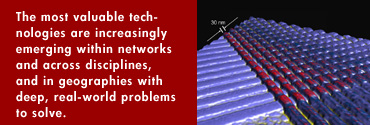
by Jamie Beckett
Computers as small as grains of sand. Inexpensive electronic
posters and billboards as sharp and clear as today’s
glossy magazines. A worldwide auction for compute power for
businesses of all sizes.
These are just a few of the projects in the works inside
HP Labs, the HP central research facility.
Dick Lampman, senior vice president for research and director
of HP Labs, offered a behind-the-scenes look into the lab
to thousands of worldwide HP partners this week at an HP
Global Partner Conference in Las Vegas.
"Our job is to invent for the company's future," Lampman
said. Increasingly, that involves working "research
networks" – a web of research partners around
the world with whom researchers co-create technologies
and solutions that provide HP customers a competitive advantage.
These partners include digital animation powerhouse DreamWorks
and global research institutions like CERN, the world's largest
particle physics lab. HP Labs also teams with major universities,
government bodies and research organizations like the Gelato
Federation, a group co-founded by HP to advance the Linux
Itanium platform."
"The most valuable technologies are increasingly emerging
within networks and across disciplines, and in geographies
with deep, real-world problems to solve," said Lampman,
noting the lab's global research presence. "Research
networks – or the knowledge supply chain – are
the prime ingredient for a successful 21st century research
lab."
Lampman, who has been at the helm of HP Labs since 1999,
also provided a glimpse at some of the lab's current projects
in areas like utility computing, plastic electronics, nanotechnology
and streaming media. These include:
• Auctions for compute power - A sort of eBay for
computing power, this is software aimed at allocating
and pricing storage and processing resources on demand.
A business
experiencing an unexpected surge in sales or Web traffic
would be able to purchase more resources as needed
at a price set by the market. The technology is being tested
by CERN
for grid-computing research and in HP Labs, where a
financial
services prototype is being developed.
• Smart cooling design - a proposition that drives the need-based
provisioning of power and cooling from chip core to
the cooling tower, dynamically allocating cooling resources where and
when they're needed most. Smart cooling cuts energy
consumption in half when compared with conventional design approaches.
•
Short-run customized commercial printing – efforts
to expand the capabilities of HP's Indigo digital press,
which provides the look and feel of high-end offset printing,
allows page-by-page customization and offers better image
quality, faster speeds, greater media flexibility and lower
cost per page than competing digital presses. HP Labs researchers
in color science, image science, computer science, image
processing, human vision, psychophysics, physics, chemistry
and mathematics – another successful research network,
Lampman noted – are driving improvements in digital
color-management systems that will transform the commercial
and industrial printing industries.
 |
|
Along with those projects, the lab "continues to
dream about tomorrow's possibilities – the 'what
if' world," Lampman said.
In one of those projects, researchers are working to devise
a method of making plastic displays that are lighter and
more robust than today's LCD displays – but about
one-fifth the cost. Just as impressive, these displays
are bistable, meaning that they retain an image even without
a power source.
"This will allow us to build displays with many more
pixels than today – say 100 megapixels instead of
one megapixel ---thus enabling print-quality pages to be
displayed electronically," Lampman said.
Perhaps the biggest "what if" project at HP
Labs is research that could lead to computers as small
as grains of sand.
Although scientists haven't achieved this yet, they are
developing molecular-scale alternatives to conventional
transistors that offer the potential for computers to be
smaller, more powerful and less expensive. Research work
in this area could make it possible to produce nearly perfect
manufacturing yields with equipment a thousand times less
expensive than today's methods.
"This is research at its best, offering HP a new
approach that will enable low-cost, high-yield fabrication
in a way never before considered," Lampman said.
In a recent survey, HP’s patent portfolio for micro
and nanoelectronics was named the strongest in the world,
he noted.
"We have to be ahead of the game," Lampman said. "We
are there now and that’s where we intend to stay.
And our partners will move with us."
Jamie Beckett is managing editor of the HP Labs Web site.
Before joining HP, she was a reporter and editor at the
San Francisco Chronicle. She is also a published fiction
writer.
|

